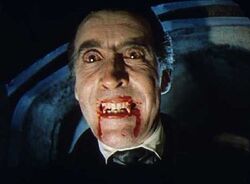Vampire
Vampires are blood-sucking humanoids of the genus Megaculex; despite their human-like appearance, they are members of the Culicidae family and therefore are more closely related to mosquitoes than humans. Their origins can be traced to the early 1400s, when the first group of the species came to surface in a notable historical event coined The Great Vampire Arrival. The scripts of the Vampire Elders tell of the day that they were "born of the earth itself", having lived in camper vans deep within it before their upsurge. They were presumably forced to surface because of the scarcity of food below.
The Vampire has been depicted in a wide variety of literature (see Bram Stoker's Dracula) and has been the focus of diverse epochs of pop-culture. Recently, however, Stephenie Meyer has been making efforts via the Twilight series to create the misconception that vampires are inhumanly beautiful, sparkle in the sun, and have relatively low IQs—which is the opposite of the truth. It is often rumoured that Meyer is secretly working to advance the vampires' agenda by fooling humans into thinking they are nice-looking and harmless, but the would-be whistleblowers always seem to disappear the next day.
In recent times, vampires have become a more economically and socially stable race, content in buying and selling Korean children, and running major fast food restaurants such as Subway and Microsoft. They are also known as Romanians.
Identifying a Vampire[edit]
There are several ways to identify a vampire:
- Disintegration when exposed to sun (Edward Cullen and company are not vampires, but body glitter-wearing evil minions of Stephenie Meyer).
- Fond of smelling underwear (this method of identification is largely frowned upon because of its applicability to rapists).
- Fond of draining underage girls/boys of blood
- Fond of watching people sleep and licking their pillows (see above).
- Bad or non-existent sense of humor (most teachers and elderlies).
- Deformed nipples (see Edward Cullen in New Moon).
- Lack of interest in cheese & garlic.
- Bisexuality (the most accurate method of identification)
- Speaking a weird language that sounds like a mix of Italian and Russian. They frequently make a moaning sound that sounds like a cross between "ee" and "oo". They spell it "â". If you see this letter, run away! They call their language "Limba Română".
- Anyone whose last name ends in '-escu'. This is their ethnic surname suffix. If you know an '-escu', plan an escape root out of the neighborhood.
- Vampire names tend to either sound like 80s rock star stage names or some obscure biblical character associated with longevity like Lazarus, Methuselah, Lilith, Zillah, or Cain; they are almost never named something common and ordinary sounding like Muhammad, Mary, Ruth, Dave or Jethro because they insist on acting like goths all the time and are terrible at keeping a low profile. It does kind of make you wonder about all those long lived prophets like Abraham who had kids when they were 100 and died when they were 170 though.
Origin[edit]
Vampires are the laughing stock of the undead community and are the lowest on the "Most Scariest" on the list. They are also known as the slightly less brain damaged version of Zombies, who are the most coolest thing to ever come about.
Initially deathly allergic to sunlight, the Vampire's communication with humans was originally extremely limited. Scientists managed to record and preserve some of the early transcripts, an excerpt of which follows below:
"WATER!!!"
A little known fact is that doctors are a subspecies of vampire, hence their affinity for blood. Unlike traditional vampires, doctors are not repelled by garlic, but can instead be kept away with an apple a day.
All of the above is part of the large conspiracy of Vampies R Us, a company which distributes misinformation about Vampiries, as they are commonly called in Transylvania. The actual Vampirie is a very shy and shallow creature that resembles a cross between a hotel-quality towel and a short, round human. They originate from the Fires Of Heckles, an easy bake oven where the Vampiries are spawned, warmed to life, and grow to maturity. When they are full grown, they exit the Fires of Heckles, and go about the world trying to be braver than they actually are. The problem with Vampiries are their insecurities. Thus, the Vampies R Us company, which is paid a large amount of money by the Vampsy Government to make them from small, fluffy and rotund Vampiries into strong, tall, and bloodthirsty Vampires. Stephenie Meyer is an excellent example of a contributor to the Vampirie Conspiracy. Now you know. Pass on the truth, and know you have nothing to fear from Vampiries.
Vampires and Emos[edit]
Despite previous beliefs and the constant attempt of emos trying to be accepted into some sort of culture. Vampires do not associate with them in any way except for food. The only other unfortunate joining of the two was when a certain unnamed vampire, being quite unaware of himself having just downed 7 pints of hippy, 2 popular kids and an unknown lump in the corner, stumbled back to his haven and bumped into wiL Francis. This mere contact caused the previously mentioned emo to beg for the vampire to bite him as he craved some sort of contact other than the gay love from his band. The vampire in its state obliged very grudgingly and thus since then we have had the mishap that is the vampiric wiL. All vampires shun him nonetheless.
Vampires In The Modern World[edit]
Vampires have become much rarer in recent years, due partly to habitat destruction and climate change. The following interview comes from The Sun, in which a German vampire describes the difficulties he faces every day:
"I haff been un professional vampire for more than three centuries, and I haff seen many changes. Life ist not so gute for the vampire anymore. Just this morning I had to go to der supermarket. Vat vould der vampire need to go to der supermarket for, I hear you ask! Vhy, do you think mein cat ist der vampire also? Nein, Tiddles ist just der normal pussycat, und I need to buy catfood and milk and kitty litter. So off to Tesco I go - I haff to use der bus. In der old days, I could just change into der fleidermaus, but nowadays ze skies, zey are so crowded! Zey ist full of der luftcraft and I vould be splattered livink vhere I do in der flightpath of Heathrow. I cannot even get der driving permit, vat vould zey say in der driving school vhen zey look at mein provisional license und see zat I vas born in 1678? Zey vould say, hang on, zis guy ist der vampire! Stake him! So by bus I must travel, and the bloody price! I cannot get der OAP discount card for der same reason as I cannot get der driving licence. It costs me £2.50 just to get to bloody Tesco! It ist disgusting vhen von hass been paying der taxes for three hundred jahre! And zen, vhen I get to der supermarket, I cannot even enter becoss just as I do not show up in der mirror, I do not show to der infra-red camera thingy vat opens der automatic door. I haff to vait until someone else goes in und zen sneak in behind dem! Und vat do I see, right by the doors as I go in? The vegetable section...vith rows und rows und shelves und shelves full of garlic! Der garlic brings me out in hives und I sneeze everyvhere! Zen der mirrors everyvhere on der valls - people notice dat I haff no reflection and zey know I ist der vampire, so they start throwing der garlic at me! It ist embarrassing for a senior citizen such as myself!"
Even in Romania, their own country, vampires face considerable difficulty:
"You know, zis new age of vampirism is very very difficult. Vlad za Impaler - he had it easy! Lots of fresh human kabobs every time he wanted one. Me, I haf to go down to the hypermarket if I want some rare steak! And it's cow blood, no good-tasting organic peasant blood from around za Carpathians! Nu! I haf to eat filthy cows. I'm a good taxpayer! I contribute to my society! Zis is Romania, you'd think they'd treat us well - but nu nu nu, even the Gypsies are better off zan us undead!"
The interview unfortunately ends at this point, the journalist noting that the vampire went on to complain about the price of fish, the lack of respect shown to the elderly by children who are your kids, Indian kids and Bill Gates himself, how there is no good music on der vireless and how he had fought in the war and now got treated like this.
Nowadays due to the threat of AIDS, Twilight, and other blood transmitted diseases, vampires have become a declining race. The ones that survived had to take up a new way of life in order to ensure their survival. They took up a ritual of drinking their own blood. They also lost the fangs in favor of sharp cutting implements.
Physiology[edit]
Vampires (Homo sapiens homovorus or Haemo sexual) are an extinct anthropophagous subspecies of Homo sapiens. Since their extinction, they have been embedded in the mythology and folklore of various cultures. In folklore, they acquired numerous supernatural characteristics, being invincible, flying, and the most common is that they were re-animated corpses of human beings. In modern times, vampires are the frequent subject of cinema and fiction. Their taxonomic name, Homo sapiens homovorus, is Latin for "human eating."
Abilities/Traits[edit]
Overview[edit]
The differences in external diagnostic features between humans and vampires were actually pretty subtle, both because vampires never lasted long enough to diverge greatly from the human baseline, and also because natural selection is going to promote superficial similarity. However, while virtually identical to modern humans in terms of gross physical morphology, vampires were radically divergent from humans on the biochemical, neurological, and soft-tissue levels. This limited significant physical changes to soft tissue and microstructures that do not fossilise. This is one of the reasons why it's so difficult to identify these creatures in the fossil record-the other reason being that they sat at the very apex of the food pyramid, which means that they were quite rare even at peak numbers.
Appearance[edit]
More gracile than Homo sapiens sapiens, gross physical divergence from baseline humans included a slight but distinct extension of the mandible, and of course of the slight elongation of canines, the classic "fangs" of the predatory grip-and-tear feeding mode (although this wasn't quite as pronounced as the popular mythology would have us believe). Vampires also tended to be taller and longer-limbed than humans. All of this was in service of an increasingly predatory lifestyle.
Vampire skin possessed a ghostly white pallor, but if they choose to stay among humans they tend to be tanned. This discoloration however, was not the result of anemia; in fact their blood volume was actually seven percent higher than that of humans. Instead their blood volume was redistributed away from the peripheral tissues and sequestered deep in the core. Sparkly vampires are a new, far weaker breed which is rightly vilified by their forebears.
Soft-tissue[edit]
They had capillary beds formed in the body core. All humans have these, the digestive system is highly vascularized to facilitate nutrient transport from the intestine into the bloodstream, but the capillary meshes in a vampire's core were far more extensive than anything seen in humans.
Tissue levels of adenosine triphosphate were elevated; ATP is the chemical battery that powers the cell, and this explains the abnormal strength and stamina that vampires displayed.
The gastrointestinal tract was foreshortened and secreted a distinct range of enzymes more suited to a carnivorous diet. Since cannibalism carries with it a high risk of prionic infection, the vampire immune system displayed great resistance to prion diseases, as well as to a variety of helminth and anasakid parasites.
Nervous system[edit]
The central nervous system is where the difference between vampires and humans really showed up. The corpus callosum was twenty percent larger in vampires than in humans. This enabled high-speed broadband communication between hemispheres. Interneuron/glial density, cortical folding and lamination were far above those in a human, particularly in the visual cortex. Their motor neuron nerve axons were almost twice as thick as conventional human nerve axons. This gave vampires faster signal transmission and faster reflexes than humans. A vampire could literally snatch a speck out of your eye before you had time to blink.
A vampire's amygdala and visual cortex – essentially, the pattern-matching wetware at the back of the head – were seven and thirteen percent larger than what is found in humans, respectively. Synaptic interconnections between the anterior cingulate gyrus and the rest of the brain were much lower than normal, almost as if the core of the brain were being isolated from the neocortex.
They also possessed some very unusual wiring in the retina. Human eyes contain whole arrays of specialized receptor cells; some fire only when they see light and shadow in conjunction, some fire only when they see horizontal lines-horizons and so on. In a vampire's case, the receptors that responded to horizontal lines were crosswired with those that responded to vertical ones. When both sets of receptors fired simultaneously in a very specific way – that is, when intersecting right angles occupied more than thirty degrees of visual arc-positive feedback generated a neuroelectrical overload in the visual cortex – the reaction could be quite dramatic. This what caused the famous adverse reaction to crosses, which consisted of violent convulsions which strongly resembled grand mal seizures. Scientists commonly call this reaction the "crucifix glitch".
Within the vampire eye there was an increased reflectivity of the retina, reminiscent of the tapetum lucidum found in the eyes of cats and other nocturnal predators. Vampires also had quadrochromatic vision; while we humans have only three types of cones in our eye vampires had four, the fourth being tuned to near-infrared.
Blood diet[edit]

The reason vampires did not resort to non-human prey and evolved such radical adaptations to accommodate human meat into their diet is because they received something from humans that they couldn't from other species. What they received that is so essential to their paleolithic diet is PCDH-Y, a protein responsible for certain aspects of central nervous system development. Vampires possessed a genetic defect that resulted in the inability to synthesize the protein. Since this protein occurs only in other hominids, human prey was essential.
Technically vampires were closer to what might be called obligate cannibals, eating human flesh rather than simply drinking the blood. However, given that the only thing they really needed from humans was a certain type of protein, it's theoretically possible that a blood diet could meet that need, although they had to drink a large amount of blood. Perhaps this was a deliberate conservation strategy; drinking the blood leaves you with an anemic victim that can recover over time and serve as a future food source, while eating the flesh basically relegates your victim to single-serving status; and vampires could feed on other species to meet most of their dietary needs. They were much more intelligent than humans, intelligent enough to figure out the virtues of resource conservation.
Because of modifications to the digestive system, PCDH-Y was obviously not broken down in the stomach as with other proteins, but instead was absorbed with its full effects into the central nervous system. Those modifications probably also included anticoagulants that stopped blood from curdling in the stomach, thereby preventing any emetic effects of ingesting blood.
The Vampire Mind[edit]

Vampire grey matter was "underconnected" compared with human norms due to a relative lack of interstitial white matter; this forced isolated cortical modules to become self-contained and hypereffective, leading to pattern-matching and analytical skills far in excess of the human norm. Vampires were omnisavants; their groove extended to pretty much every logical and pattern-matching dimension known to man, and more besides. They were insanely smart by human standards. Vampires had to be smarter than people, because they hunted people for a living. Lions are smarter than gazelles for pretty much the same reason.
By the same token, something else vampires had to be is clinically sociopathic. Among our own kind, a lack of conscience, of empathy for one's fellow human beings, is considered a pathology. Among vampires, though, sociopathy is an essential survival trait. If you felt empathy for your prey, you'd starve to death. Natural selection would have weeded "moral" vampires out of the gene pool relatively fast. On the biological level, the sociopathy was caused by the poor connection of the anterior cingulate gyrus, as its ventral area is related to emotional cognition.
Sexuality[edit]
Despite the common perception of vampires as seductive Casanovas, there is in fact a rising LGBT vampire community.
One of the most well known portrayals of a gay vampire struggling to come to terms with his sexuality can be seen in the novel Twilight by Stephenie Meyer. The protagonist, Edward, desperately attempts to prove that he is straight, even going so far as to date and romance a whiny cover. Though Bella is depressed, mousy, and bland, Edward stays with her, claiming that he "loves her" and "can't live without her". Desperation and faulty attempts to display love and affection come through in the brilliant acting of Robert Pattinson, and Kristen Stewart's unbearable Bella does a magnificent job of stressing the need for Edward to step out of the closet.
As the books progress, Edward finds himself confronted with the pressure to have intercourse with Bella. Desperate, he manages to spin bullshit about "true love", "preserving innocence", and "getting married". Though skeptical at first, Bella eventually acquiesces, ensuring Edward the lifelong cover he thought he wanted.
In recent years it has become a trend for men of all ages to profess their love of the book to confirm that they are in fact gay themselves.
Reproduction[edit]
As the classic mythology would have it, vampires reproduced by turning their victims into other vampires. Revisionists and horror writers have played around with the idea of vampirism as a kind of viral infection, an STD transmitted from saliva to blood. Biologically, of course, there are some problems with this idea: if you create another vampire every time you feed, it won't be long before all your prey have been turned into vampires, all of which will get very hungry very fast. However, the idea isn't as absurd as it may seem on the surface.
Lateral gene transmission is not unheard of in nature; certain microbes are known to act as carriers for the DNA of other species, transmitting them from one host to another; and in any event, it appears that predator and prey share many of the same genes anyway; perhaps the only thing that needs to be transmitted is some kind of catalyst to activate them. More conventionally, vampires and humans never achieved complete reproductive isolation in any event; there's no reason why interbreeding couldn't produce vampire offspring, especially if the critical vampire genes were heterozygously dominant.
Many scientists have theorized that the genes responsible for vampirism are widely spread amongst the human population, simply dormant in most people. They lie within penis DNA, which are ancient genes that haven't expressed themselves in thousands of years. These scientists believe that in certain cases, some of these genes do express spontaneously; that psychopathy, autism and certain types of schizophrenia arise partly from the partial expression of these genes in a broken and rudimentary form. That sociopaths and savants show us one or two bits of the vampire subspecies. Of course, these harmful genes stay away from large black males named Will Smith, and Tiger Woods.
Myths[edit]
The crucifix glitch is most likely the source of the myth that vampires can't enter someone's house uninvited. It would be more accurate to say that vampires couldn't come into a house unless they kept their eyes closed; and since that would have made them extremely vulnerable to attack, they usually could only enter a house when the house's inhabitants didn't wish them ill.
Vampires had very sensitive night vision and their pupils didn't react as quickly as humans to changes in light intensity; they could be easily snowblinded. Although it couldn't cause them to burst into flame when struck by the sun's rays, but it might explain a general aversion to bright light. A crowd of peasants with torches most likely presented a real problem to the subspecies.
It's possible that vampires themselves spread the myth of garlic repelling them, to engender a false sense of security among their prey. It's also possible that the whole story is pure fiction.
A lot of other myths – that vampires can fly, or shapeshift, or that they don't reflect in mirrors – are likely to be mostly fiction as well. But it's worth remembering that these creatures were both faster and more intelligent than humans, and their superlative pattern-matching skills would have given them a real advantage in "blending in" via crypsis; it's quite likely that one might seem to disappear simply by fading into shadow, or adopting a posture that broke up its outline against the background. Combine such a vanishing act with, for example, the flushing of some startled animal caught in its path, and a primitive human might think that some kind of shape-shift had occurred.
See also[edit]
- HowTo:Be a vampire hunter
- Vampire Americans
- Vampire ants
- Underworld (2003 film)
- Goths
- Emos
- Fidel Castro
- Vampire Ninja
- Lestat de Lioncourt
- Vlad the Impaler
- Stephen Harper
- Dracula
- Wallachia
- Transylvania
- Count Chocula
- Count Dooku
- Dio Brando
- Kitsune
- Twilight (novel)
- Michael Howard
- Leeches
| ||||||||||||||||||||||||||||||||||||||||||||||
| ||||||||||||||||||||





